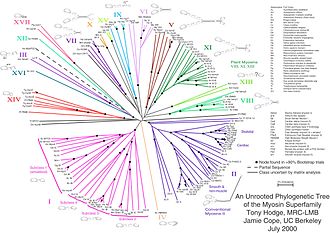Myosin
Myosin is a protein, that is one of the main functional and structural components of a muscle fibre. It occurs in all animal cells as the basis of the locomotor apparatus, the cell cytoskeleton.
Structure[edit | edit source]
The molecular weight of myosin is 480,000. There are seventeen different classes (types), in human muscles there is type II myosin.
The molecule itself consists of 6 polypeptide chains: 2 heavy and 4 light. The heavy chains wrap around each other and form a "tail" of the molecule on one side, and a double globular structure on the other, the so-called "head". 2 light chains are attached to each "head". The "head" turns into a "tail" in a flexible "neck".
Myosin myofilament[edit | edit source]
200 identical myosin molecules, gradually overlapping each other longitudinally, form a myosin myofilament by mutual connection. Their "tails" are formed by the body of the myofilament. Myosin "heads" on flexible "necks" protrude from the body of the myofilament at regular intervals. A myofilament is 1.6 µm long. In the cross-section, the "heads" are located every 60° (6 around the circumference).
Function[edit | edit source]
Each „head“ has an actin- binding site and an ATP-hydrolase enzyme. The enzyme releases the chemical energy that is needed for active movement in the "neck", enabling mutual displacement of actin and myosin myofilaments and subsequent muscle contraction (muscle contraction).
Links[edit | edit source]
[edit | edit source]
References[edit | edit source]
- KITTNAR, Otomar. Lékařská fyziologie. 1. edition. Praha : Grada, 2011. ISBN 978-80-247-3068-4.


